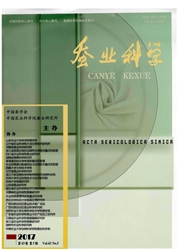

 中文摘要:
中文摘要:
线粒体基因组是研究物种进化的良好材料。对采集自广西壮族自治区的蓖麻蚕样进行线粒体基因组测序,其序列全长15 420 bp,含有13个蛋白质编码基因、2个核糖体rRNA基因、22个转运RNA基因,并呈现典型的鳞翅目昆虫线粒体基因组的组成成分及基因排布顺序。序列分析表明,该基因组的蛋白质编码基因的起始密码子除细胞色素C氧化酶Ⅰ基因(COⅠ)使用TTAG外,其余基因均使用典型的起始密码子;tRNA基因除tRNASer(AGN)基因外,其余均具有典型的三叶草结构。该基因组的A+T含量为79.85%,低于其它蚕蛾总科昆虫,编码基因倾向使用第3位碱基为A或T的密码子。基于广西蓖麻蚕的线粒体全基因组序列以及已报道的其它鳞翅目昆虫的线粒体基因组序列,推断这些鳞翅目昆虫的系统发生关系和进化历史:蓖麻蚕与大蚕蛾科的昆虫有较近的亲缘关系,可能在距今约31.71 Ma前与其它大蚕蛾科昆虫分开;鳞翅目昆虫可能在距今149.71 Ma前,即侏罗纪后期开始分化,并在白垩纪至早第三纪早期形成不同的物种。研究结果为深入理解鳞翅目昆虫线粒体基因组的系统进化提供了数据补充。
 英文摘要:
英文摘要:
Mitochondrial genome is a good material for evolutionary study of species. In this study, the complete mito- chondrial genome (mitogenome) of eri-silkworm (Philosamia cynthia ricini) which was sampled in Guangxi Zhuar~g Au- tonomous Region of China was sequenced. The complete mitogenome of eri-silkworm is 15 420 bp in length and contains 13 protein-coding genes, 2 ribosomal RNA and 22 transfer RNA (tRNA) genes. The newly sequenced genome displays the similar genomic components and gene order as the typical lepidopteran mitochondrial genome. Sequence analysis re- vealed that the presence of standard mitochondrial start codon was shared by most protein-coding genes, except cyto- chrome C oxidase I gene ( CO I ), which uses TTAG. All tRNA genes exhibit the typical cloverleaf structure except fortRNAser(AGN). A +T content of mitogenome is 79.85%, which is lower than other Bombycoidea insects. Coding genes tend to use the codons with A or T at the third posi- tion. The eri-silkworm and other lepidopteran mitogenomes were used to infer the phylogeny and evolutionary history of these lepidopteran insects. The results showed that eri- silkworm has closer relationship with other Saturniidae in- sects, and their divergence time was about 31.71 millionyears ago (Ma). In addition, our results revealed that the lepidopteran insects might begin diversifying in the late Juras- sic Period (about 149, 71 Ma), and formed different species during the Cretaceous and Paleocene. Our study provides useful data for elucidating the phylogenesis of lepidopteran mitochondrial genomes.
 同期刊论文项目
同期刊论文项目
 同项目期刊论文
同项目期刊论文
 Molecular cloning and characterization of ecdysone oxidase and 3-dehydroecdysone-3alpha-reductaseinv
Molecular cloning and characterization of ecdysone oxidase and 3-dehydroecdysone-3alpha-reductaseinv 期刊信息
期刊信息
